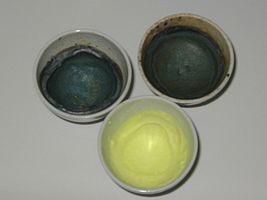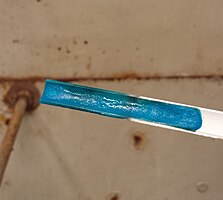Digestion (chemistry)
A shed is a process of inorganic-chemical analysis in which poorly soluble substances, often oxides , silicates , with the aid of disintegrants in one or sulfates acid - or water-soluble compound are transferred.
However, chemical dissolution can chemically change the substance and the matrix. Possible sources of error during digestion are:
- Loss of substance through volatilization
- Adsorption on digestion vessels
- Contamination by disintegrants
Soda-potash digestion
In the case of soda-potash digestion, also called alkaline digestion, a mixture of soda ( sodium carbonate ) and potash (potassium carbonate) in a ratio of 51.5%: 48.5% ( eutectic mixture ) is produced and in about six times the amount together with the material sample melted. The primary purpose of adding potassium carbonate is to reduce the melting temperature of the mixture from over 850 ° C to approx. 712 ° C.
Examples:
- Soda-potash digestion of aluminum oxide
- Soda-potash digestion of barium sulfate
Acid exposure
Melting with potassium hydrogen sulfate in a ratio of 1: 6 is suitable for breaking down basic metal oxides.
- The digestion takes place with sulfur trioxide, which reacts further to form sulfate anions.
Examples:
- Digestion of iron (III) oxide with potassium hydrogen sulfate
- Digestion of iron (III) oxide with potassium disulfate (ratio 1: 3)
Freiberg outcrop
The Freiberg outcrop, named after the Bergakademie Freiberg , is also known as a sulphurizing outcrop. Sparingly soluble oxides of metal ions that form thiosalts can be converted into soluble thio compounds. To do this, the substance is melted with six times the amount of a mixture of equal parts of sulfur and sodium carbonate.
Example: Freiberg digestion of tin stone SnO 2 to thiostannate ions SnS 3 2−
Oxidation melt
Acid-insoluble oxidizable substances such as chromium (III) oxide and manganese dioxide can be digested with the aid of an oxidation melt. For this purpose, the substance is melted in a porcelain crucible with up to three times the amount of a mixture of sodium carbonate and potassium nitrate. The substance is oxidized and the added nitrate is reduced to nitrite.
In qualitative inorganic analysis, the oxidation melt is also a detection reaction for chromium and manganese salts in the ammonium sulfide group in the cation separation process .
Examples:
- Oxidation melt of green chromium (III) oxide to yellow chromate
- Oxidation melt of iron (II) chromite ( chromite ) with potassium carbonate and sodium nitrate to yellow chromate and iron (III) oxide
Further procedures
Another method for the digestion of poorly soluble substances, especially for platinum and gold, is boiling in aqua regia (see also aqua regia digestion ) with subsequent smoking (removal of acid residues).
In the alkaline oxidation melt, precious metal / metal compounds from catalyst burn-offs, alloys or ore concentrates are broken down in a sodium hydroxide melt with an oxide-containing salt (such as chlorate or nitrate) at high temperatures.
Sodium digestion is also occasionally used for solids , especially for the analysis of simple anions (e.g. chloride ions). The sample is heated with elemental sodium in a glass tube, taken up with water and filtered.
In microwave digestion , energy is transferred directly to dipoles of polar solvents. The rapidly changing electrical field of the microwave causes the water molecules to rotate and thus heat up through “internal friction”. One advantage of the technology is the even heating of the sample, which shortens the digestion time.
There is also a digestion with a mixture of chloric acid and perchloric acid .
literature
- Gerhart Jander, Ewald Blasius: Textbook of analytical and preparative inorganic chemistry. 16th edition. S. Hirzel Verlag, Stuttgart 2006, ISBN 3-7776-1388-6 .
Web links
Individual evidence
- ↑ G. Jander, E. Blasius: Textbook of analytical and preparative inorganic chemistry. Hirzel, Stuttgart 1983, p. 131 f.
- ↑ Bernhard Schreiber: Trace analysis. In: Herbert Feltkamp, Peter Fuchs, Heinz Sucker (eds.): Pharmaceutical quality control. Georg Thieme Verlag, 1983, ISBN 3-13-611501-5 , p. 353.













